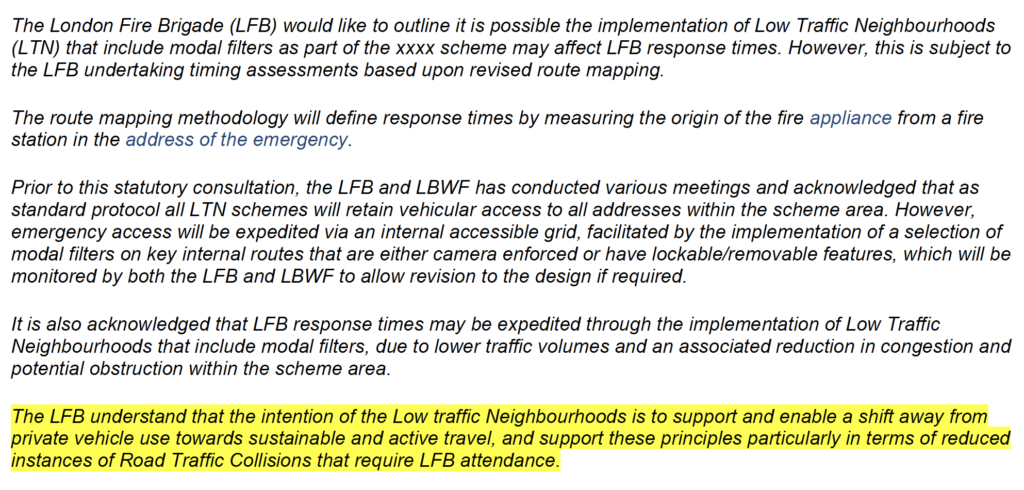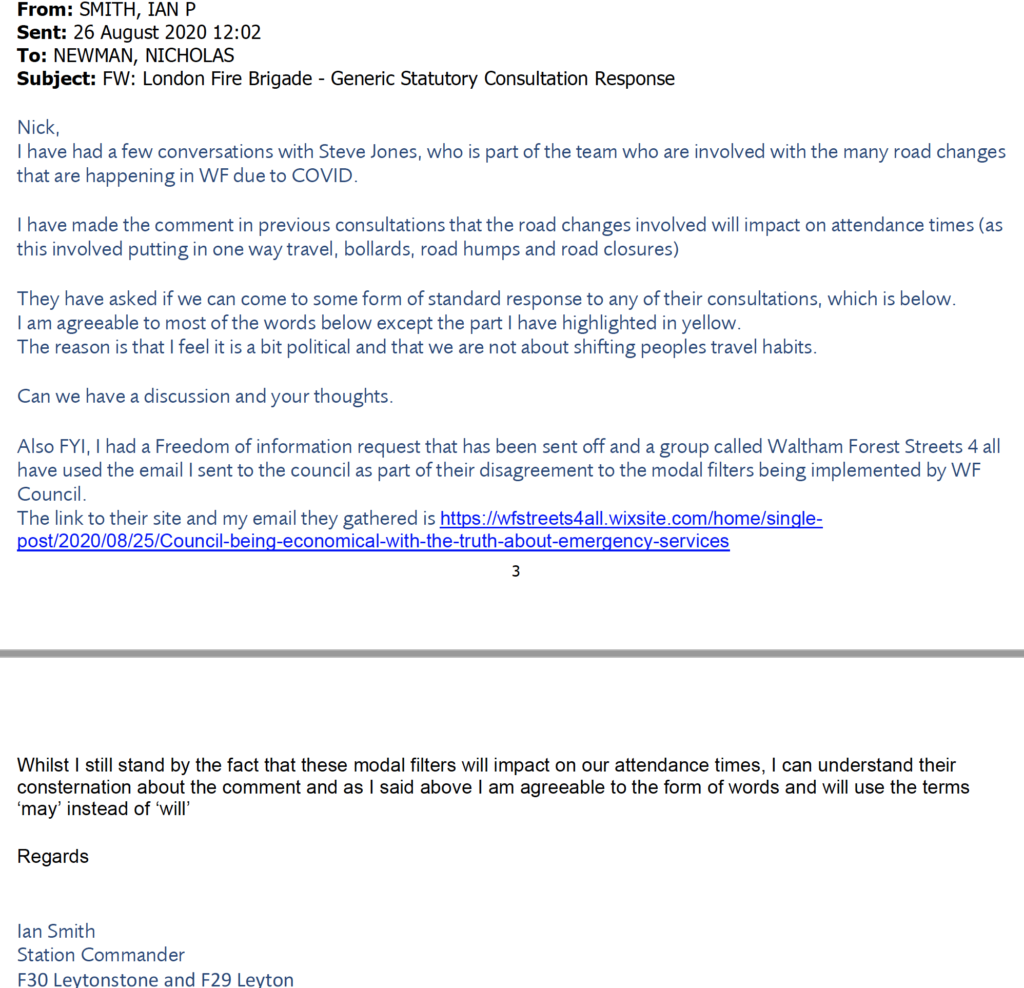LBWF, the London Fire Brigade, and ‘controlling the narrative’ over fire crew response times in Low Traffic Neighbourhoods
As this blog has reported over the years, LBWF spends a good deal of time and money attempting to ‘control the narrative’, that is burnish its reputation through fair means or foul and, crucially, head off legitimate criticism.
Previous posts have looked in detail at how this works, focusing on spin (‘the selective assembly of fact and the shaping of nuance to support a particular view of a story’) and manipulation of the Freedom of Information Act (FIA), the latter recently provoking a firm rebuke from the Information Commissioner’s Office.
However, a short sequence of e-mails lately obtained by redoubtable Walthamstow resident, Charlie Edwards, apparently shows that LBWF uses softer forms of influence, too.
The subject at hand is LBWF’s decision to build on its cycle-friendly Mini-Holland scheme by creating a plethora of Low Traffic Neighbourhoods (LTNs), and specifically its intention to make sure that the London Fire Brigade (LFB) is completely onside.
This is a sensitive matter for both parties, because in Waltham Forest, as elsewhere in London, there is an ongoing and sometimes acrimonious debate about whether, with their ‘modal filters’, one-way streets, and so on, LTNs slow fire crew response times.
As might be imagined, for its part, LBWF sees this is as something of a non-issue. It claims to have engaged in detailed consultation with all the emergency services before starting work, and believes that, as a consequence, if there are problems, these will be minor and quickly resolved. Indeed, LBWF Deputy Leader, Cllr. Clyde Loakes, speaking at a Labour Cycles national webinar, has gone so far as to assert, ‘And the fire brigade of course you know saw improved response times in Waltham Forest after we started putting in our modal filters’ [emphasis added].
To LBWF’s irritation, however, a significant number of residents clearly remain unconvinced. Social media platforms regularly highlight incidents where ambulances and fire engines have been thwarted by LTN hardware, and provide vivid and disturbing details. Doubts remain about whether LBWF really possesses the evidence to back up its assertions. Extraordinarily, when earlier this year Mr. Edwards used the FIA to ask LBWF for the ‘proof’ which justified Cllr. Loakes’ bullishness about response times, he was told: ‘The Council does not hold this information’. And it has not passed unnoticed that while a new academic study of LFB performance in the borough concludes ‘Our findings indicate that low traffic neighbourhoods do not adversely affect emergency response times’, its authors nevertheless feel it prudent to acknowledge that ‘some’ local fire crews believe exactly the opposite.
That’s the background, so what story do Mr. Edwards’s discoveries tell?
The sequence begins in August 2020 with LBWF project officer, Stephen Jones, e-mailing Station Commander Leytonstone and Leyton, Ian Smith, about a collaboration that they have been working on, described as ‘an initial draft for the LFB to consider as a generic response to LBWF statutory consultations’, which reads thus (the highlighting is in the original):
This prompts Mr. Smith to contact Borough Commander Waltham Forest, Nicholas Newman, attach the draft, as above, and ask for some advice:
In reply, Mr. Newman suggests contacting LFB headquarters, in order to be ‘clear our position is aligned with the Brigade position generally’, and adds:
‘I am not sure what timing assessment work is in the pipeline and also not sure there is evidence that the changes will expedite attendances’.
And that brings the sequence to an end.
Needless to say, these e-mails are fragmentary, and what happened after they were written is unknown. It is entirely possible, for example, that LBWF and the LFB simply never produced the ‘generic statement’ that Mr. Jones planned in August 2020.
Nonetheless, there is enough here to prompt three reflexions.
First, many will be surprised at how closely LBWF and the LFB are revealed to be collaborating. Both organisations know that statutory consultations are to happen sometime in the near future. Both also desire, apparently, to ensure that, when it does happen, no snags occur, and outcomes are mutually congenial.
Some will see this as a prudent and mature way of conducting business, others a blatant attempt to engineer a fix.
Second, LBWF’s attempt to insert into the proposed draft a paragraph about reducing private vehicle use also is arresting. Of course, whether or not the LFB in the end played ball is unknown. But was it really LBWF’s business to proselytise in this way? After all, it is universally accepted that the LFB is independent of party politics, and should stay that way.
Finally, there is the matter of Mr. Smith’s ‘may’ instead of ‘will’.
The background here is pertinent. In August 2021, the pressure group Waltham Forest Streets For All submitted a FIA request for information about the LFB’s reaction to LBWF road closures in the Hilltop area of E17.
Replying in mid-July, a LFB staffer reported that she had contacted the ‘Station Commander’ – subsequently revealed to be Mr. Smith – who ‘confirmed that Waltham Forest did consult with us on the proposals and it was observed that the proposals for that area could impact on response times’ [emphasis added].
However, rather confusingly, she also attached a June 2020 internal e-mail that Mr. Smith had sent to colleagues where he was much more forthright, declaring: ‘all modal filters and road closures will impact on the attendance times of all our emergency vehicles’ [emphasis added].
Why Mr. Smith in the end jettisoned ‘will’ for ‘may’ is unclear. Perhaps he believed ‘will’ could be interpreted as ‘always will’, and felt such a degree of certainty was unjustified. On the other hand, perhaps Mr. Smith buckled under pressure from his superiors. In 2019, Her Majesty’s Inspectorate of Constabulary and Fire and Rescue found that though ’well-resourced’, the LFB was, in the Guardian’s encapsulation, ‘one of the worst in the country’. A 2021 report was also critical. Meanwhile the LFB has been engaged in an organisation-wide review of its own culture following a firefighter’s suicide. With all that in mind, the LFB hierarchy may have decided that the last thing it needed was a row with a local authority, moreover one well plugged into wider Labour Party networks.
As of today, debate about LTNs and fire crew performance continues, with a just completed study by local resident Steve Lowe, which uses publicly available statistics, concluding ‘there is substantial evidence to support the contention that the attendance of the LFB at emergencies in Waltham Forest has been delayed by the road closures that have been introduced extensively in the borough’.
Whatever the case, Mr. Edwards deserves our thanks for illuminating a rather murky corner.


